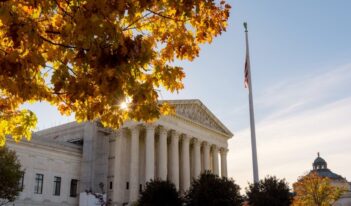
The Clean Air Act’s success reveals the flaws in the standard critique of the administrative state.
Over the last decade, critics of the regulatory state have complained that an out-of-control executive branch has harmed the American people by hampering economic growth and that Congress needs to reassert itself to constrain this misbehavior. I disagree with both the diagnosis of the illness and the cure.
My focus in this essay is regulatory policy. I do not deal with foreign policy, war-making, or homeland security. And, within the domain of regulatory policy, my focus is on environmental regulation, particularly regulation under the Clean Air Act, where the benefits and costs of regulation are highest and the vitriol of regulatory opponents has been most pronounced.
The criticism of the regulatory state breaks down into five propositions: first, that Congress is paralyzed by gridlock; second, that, as a result, the executive branch has stepped into the breach; third, that this outcome is undesirable as a matter of policy; fourth, that the regulatory state is an affront to our constitutional system of separation of powers; and, fifth, that to solve this problem, Congress should seize greater control over administrative agencies. I agree with the first two propositions but disagree with the next three. I also have a still deeper concern about how recent, related actions by the Trump Administration are moving regulatory policy in the wrong direction.
On the first proposition, there appears to be consensus that in recent years Congress has become increasingly gridlocked. One effort to measure congressional gridlock looks at the percentage of salient legislative items that failed to pass, finding an upward trend since the mid-20th century. Between 2011 and 2012, for instance, Congress failed to pass 71 percent of salient legislative items on its agenda, ranking it as one of the two least productive Congresses between 1947 and 2012. The concern about congressional gridlock has not abated during the Trump presidency, despite Republicans controlling both houses of Congress and the presidency.
On the second proposition—namely, that the executive has stepped into the breach—I agree that the last decade has seen a healthy dose of regulatory activity. In particular, the Obama Administration sought to address significant air pollution problems that pose serious harms to public health, in some cases carrying out nondiscretionary statutory duties and in others exercising its discretion pursuant to congressional delegations of authority.
Moving to my disagreements, the third claim—that this use of executive authority is undesirable as a matter of policy—is seriously misconceived. Since 1981, every President has had in place an executive order requiring, except where otherwise provided for by statute, that major federal regulations be justified by reference to cost-benefit analysis. The purpose is to ensure that the benefits of major rules justify their costs.
Every analysis of recent major air quality regulations has shown that they produce enormous net benefits—that is, benefits minus costs. For example, a prospective study of the Clean Air Act published in 2011 by the U.S. Environmental Protection Agency (EPA) projected that the statute would produce annual net benefits of about $1.9 trillion by 2020. More recently, studies of two major air rules that the Trump Administration is currently reconsidering, the Mercury and Air Toxics Standards and the Clean Power Plan, estimated that each would have annual net benefits of tens of billions of dollars.
These net benefits are so large because the rules save a large number of lives, in addition to preventing serious health effects such as heart attacks, strokes, and asthma episodes. The prospective study of the Clean Air Act estimated that controlling air pollution prevented 160,000 premature adult deaths in the United States in 2010 and that the number would rise to 230,000 deaths prevented annually by 2020. These figures represent about two million American lives saved between 2010 and 2020. Just one of the regulations implementing the Clean Air Act, the Cross-State Air Pollution Rule, averts tens of thousands of premature deaths each year.
The fourth claim—that what the agencies have done threatens separation of powers—is similarly without merit. An oft-repeated separation of powers complaint is that when Congress enacted the modern version of the Clean Air Act in 1970, it was focusing on local pollutants and not on global pollutants like greenhouse gases. So, the rhetorical question goes, what gave EPA the authority to regulate greenhouse gases decades later?
In 1970, Congress decided not to name in the statute the particular pollutants that should be regulated, instead delegating to EPA the determination of what qualified as an “air pollutant” for the purposes of the statute. Congress did so because it wanted the agency to subject more pollutants to regulation as new scientific evidence emerged. And, applying the statutory definition of “air pollutant,” the Supreme Court held in 2007 that greenhouse gases count as air pollutants for the purposes of the Clean Air Act. This statutory interpretation hardly seems like a poster child for executive branch overreach, particularly since the Supreme Court in this case actually set aside the agency’s initial decision not to regulate greenhouse gases.
And, fifth, the current calls for Congress to reassert itself are not efforts to improve regulatory policy or, for that matter, to deal with any separation of powers problems. Instead, these proposals are part of a concerted campaign—motivated by a myopic focus on reducing compliance costs—to put an end to the protections that save so many lives and produce such large net benefits.
The regulatory reform bills introduced in recent years indicate this short-sighted, anti-regulatory zeal. For example, the proposed Regulatory Accountability Act—which probably has the most support among these bills—would make it easy for the regulated community to obtain a trial-like hearing for significant rules. This change would essentially turn notice-and-comment rulemaking into formal rulemaking, hardly a recipe for improving the quality of agency decision-making. It is, instead, a recipe to significantly delay and perhaps defeat regulatory action of any kind. In the most infamous instance of the use of formal rulemaking in a regulatory proceeding, it took almost a decade to determine whether peanut butter should consist of 87.5 percent or 90 percent peanuts.
Could Congress in theory modernize statutes so that regulation could be more effective? Sure, in theory, that could happen. But that is quite unlikely to happen with the current Congress.
Now, to my still deeper concern: As I mentioned earlier, since 1981 there has been a consensus, under administrations of both parties, that regulations should be justified by reference to cost-benefit analysis. This requirement has served the nation well, until recently. As I indicated with the Clean Air Act example, the proof in the past has been in the pudding.
But now, this Administration has mounted an attack on cost-benefit analysis across a number of different regulatory areas. Consider just three recent developments.
First, President Donald Trump’s Executive Order 13,771 requires a cap on costs, suggesting that the goal is only to minimize overall regulatory costs, not to maximize the net benefits of regulation. Any respected economist would cringe at this one-sidedness. Why should regulators ignore the deaths averted, the reduced number of hospitalizations, the morbidity reductions, and other significant decreases in the well-being of Americans?
Second, the Trump Administration has justified many of its efforts to delay, stay, or suspend Obama Administration regulations by referring only to the cost savings to regulated industries, without looking at the forgone benefits to the regulatory beneficiaries. On this front, the Trump Administration has already suffered significant losses in the courts. But these actions, even if ultimately unsuccessful, reveal the Administration’s mindset.
Third, the proposed repeals of Obama Administration regulations do violence to cost-benefit analysis. For example, in the proposed repeal to the Clean Power Plan, EPA analyzes a scenario under which the co-benefits—or indirect benefits—of the regulation are not taken into account, even though the agency urges more extensive consideration of the indirect costs of regulation. To take into account the indirect negative consequences of regulation but ignore the positive ones is the very embodiment of “arbitrary and capricious” conduct, prohibited by the Administrative Procedure Act.
The era in which agencies counteracted congressional gridlock by acting under authority delegated to them through existing statutes and generally guided by cost-benefit analysis brought Americans enormous net benefits, greatly enhancing societal well-being. The United States has much cleaner air and water and much safer workplaces and consumer products. And the American economy has grown significantly in the period when all this happened.
Unfortunately, the nation now appears to be entering a time when this desirable state of affairs is at risk. But the courts have the tools they need to ensure that agencies, in their zeal to deregulate, do not violate the rationality requirements embodied in the Administrative Procedure Act and well-established doctrines of administrative law.
This essay is part of a three-part series, entitled Dissecting the Debate Over Regulation.




